Tag: OHC
#notoralhistory
by Shanna Farrell
@shanna_farrell
During the first few months that I was settling into life in the Bay Area after moving across the country, I often listened to WNYC, a New York City-based radio station. One morning, as I was riding my bike to work, the host of their call-in show, akin to KQED’s Forum, announced the upcoming segment.
“What was better back in the day?” the host asked. “It’s an oral history of nostalgia, starring you. Tell us about what you think was better from a previous era, why you miss it, and whether you think it’s better because of nostalgia, or because things were, empirically, better back in the day. Call us or post below.”
My heart started to race. This call out felt so personal. They had gotten it so wrong. I pulled over and dialed their number. A producer answered, unaware of their error.
“I just heard your next segment is on the oral history of nostalgia,” I said. “But that’s not oral history.”
Confused, she asked me to explain what I meant. It was October of 2013, and I was fresh off earning a Master’s Degree in Oral History. I had spent a year taking method and theory classes, learning about what defines the discipline, exploring its boundaries. I had my interviews critiqued, my questions workshopped, and had been pushed to dig deeper into my research, all in the name of preparation. This felt dismissive of the work that we oral historians put into our interviews. It devalued the time (and money) that I’d put into my degree, and the job that I had just landed at UC Berkeley’s Oral History Center.
As I tried to explain what oral history is and how what they were doing in this segment wasn’t it, I realized it would be impossible to fit into a two sentence elevator pitch. There’s so much that defines oral history, that makes it unique, distinct from other methods, that I could feel myself having trouble reducing it to something easy to pitch, just as they had to listeners.
Looking back on that moment, I wish I would have said that oral history is defined by the planning, the transparency, the collaboration, the recording, intersubjectivity, the preservation, the legacy. I wish I would have said that it could take weeks to carefully research and write an interview outline, hours to build rapport, and months to complete an interview series. I wish I would have said that it takes practice to craft questions and to listen in stereo, picking up on the things that aren’t said, and to be comfortable sitting in silence.
After I hung up the phone, I thought about why they called this segment “oral history.” I’m still thinking about it. The term became popular when magazines started running vox populi style interviews weaving together soundbites from different people to create a narrative. They ran pieces about the about the making of a movie, like Jurassic Park, or a TV show, like The Simpsons. Later, it became a household term when StoryCorps partnered with NPR to bring us our Friday driveway moments, produced from a carefully edited interview excerpt. Lately, it has seeped into literature. More and more, I see “oral history” to describe a work of memoir, creative nonfiction, and even fiction. Recently, I was reading the Sunday New York Times book review section and they positioned a new memoir as “part oral history, part urban history.” I couldn’t wrap my head around what this meant. How was it oral history? Had the author done interviews? How was this different from a regular memoir? And lately, I’ve seen a few journalists refer to themselves as oral historians without seeming like they have a solid understanding of what the term means, aside from it involving interviews.

Where does this lack of understanding stem from? Why is the term “oral history” battered around so easily? When did it first get misappropriated? The origin of the Entertainment Weekly and Vanity Fair versions are relatively straightforward, descending from the Jean Stein-style books like Edie: American Biography, which is constructed from interviews with people who knew Edie Sedgwick after her death in 1971, or books that recounted musical eras, like We Got the Neutron Bomb by Mark Spitz and Brendan Mullen (which also served as my first introduction to oral history when I was in high school) or Please Kill Me by Legs McNeil and Gillian McCain. As for where the rest of it came from – like the recent trend in literature – it’s anyone’s guess.

I’m not the only one who has been noticing this trend. In 2014, the anonymous user @notoralhistory joined Twitter. For a while, they tweeted examples of people labeling articles or projects as oral history that were, indeed, not actually oral history. They now promote examples of oral history and engage in conversations around best practices. There are practitioners who also tweet bad examples of oral history, using #notoralhistory, which are often amusing, and then maddening, and then amusing again.
The problem with these mediums is that they can’t accomplish the same things that actual oral history does. These narratives just provide soundbites, while oral history gives us much more context. They don’t include any audio (or video), so we lose the ability to connect with a human voice. They are highly edited, whereas oral history allows people to speak in their own style. They are usually layered with other voices, instead of giving someone individual space to fully narrate their own story.
The link in @notoralhistory’s bio takes you to the Oral History Association’s website, to the page where they define oral history. Here, they share a quote from Donald Ritchie’s book, Doing Oral History. He writes:
“Oral History collects memories and personal commentaries of historical significance through recorded interviews. An oral history interview generally consists of a well-prepared interviewer questioning an interviewee and recording their exchange in audio or video format. Recordings of the interviews are transcribed, summarized, or indexed and then placed in a library or archives. These interviews may be used for research or excerpted in a publication, radio or video documentary, museum exhibition, dramatization or other form of public presentation. Recordings, transcripts, catalogs, photographs and related documentary materials can also be posted on the Internet. Oral history does not include random taping, such as President Richard Nixon’s surreptitious recording of his White House conversations, nor does it refer to recorded speeches, wiretapping, personal diaries on tape, or other sound recordings that lack the dialogue between interviewer and interviewee.”
Oral history can accomplish so much. It gives us insight into the past, hearing directly from the people who lived through various moments in history. By archiving the recordings, we can listen to how narrators tell their stories, and gain insight into why they told it this way. We can put a human face on history and learn from those who came before us. And, when oral history is done right, through careful preparation, research, and recording, we can ensure that these people are not forgotten, their stories not reduced to a soundbite.
It is with similar intention that we are devoting many of our articles this month that revolve around the boundaries of oral history. You’ll hear from us about our experience doing oral history and what makes it different from other disciplines and methods. We hope you follow along.
A Q&A with Dr. Robert Keith Collins, Guest Speaker at the Oral History Center’s Advanced Summer Institute
One of our favorite parts of the Oral History Center’s annual Advanced Summer Institute is the opportunity to hear from others who are using oral history in their work. One of our favorite guest speakers, Dr. Robert Keith Collins, will be back again to discuss how he uses oral history, and person-centered ethnography, in his work on American Indian cultural changes and African and Native American interactions in North, Central, and South America.
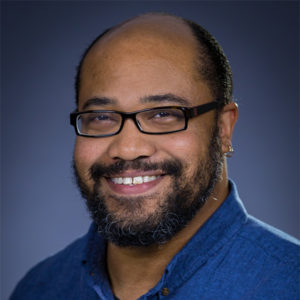
Q: How did you come to oral history?
Oral history has been something that I have grown up with, as the telling of family stories was a way that my family ensured I knew who my relatives were, what they were, where they were from, and what they went through. In my professional career, my exposure to oral history came through studying anthropology, Native Americans studies, and Ethnic Studies, particularly African American cultures and histories. Within these fields of study, oral history told the stories uncorroborated by the historical record. Although, eventually some were. This taught me that oral histories and written histories are two sides of the same coin. Both records are accounts of the past; however, oral history offers insight into the agency individuals exert in their lives and the observations that they make of the world around them.
Q: How do you use oral history in your work?
In my research, I take a person-centered ethnographic approach, which looks at individuals within cultures and how they remember their past through what they say, do, and embody. Respondents are interviewed at least fifteen times to show their evolving understanding of lived experiences. The oral histories that are obtained reveal how individuals understand their experiences, may say one thing and do another in certain situations for an expected outcome, and remembered pasts that have been actively – not passively – navigated and negotiated though choices. From these, my analyses attempt to be holistic by examining the relevance of what individuals say, do, and embody on how they impact the people around them and how the people around them shape their choices and experiences.
Q: Your work deals a lot with race and identity, particularly in the Choctaw Nation. How do you feel that oral history is uniquely positioned to explore questions of identity?
My work deals with race and identity among Choctaw descendants both within and outside of communities with significant populations. The reason my work has evolved this way is that I have found commonalities in Native American mixed-blood populations, both black and white, who experience daily challenges to the ancestries that they assert, while trying to maintain their sense of self as a person of Native American ancestry and/or cultural practices. Oral history, as a resource, allows me to explore the Works Progress Administration (WPA) Slave narratives for the lived experiences of enslaved individuals of blended African and Choctaw ancestry and those of unmixed ancestry that were Choctaw in cultural practices and language. Through these oral histories, I am also able to examine how they coped with slavery, especially those that were bought and sold by both Choctaw and white American slave holders and needed to adapt to the lifeways of each. It is important to remember that the WPA interviews represent a body of oral histories that center on a question rarely asked of formerly enslaved individuals: What was it like to be a slave? The person-centered ethnographic approach allows me to interview and listen to their descendants and analyze how individuals continue to cope with the inconsistencies between identification as Choctaw descendants while being racially recognized as black or white. I have found that oral history help us examine the answers to the question “Who am I?” that respondents give far better than any other medium, as there is very little that one can learn about individual lived experiences from collective or group experiences, except for common experiences, which shed more light on the social rather than experiential phenomena.
Q: You’ve discussed a person-centered ethnography as an approach to oral history. Could you describe this and share an example of how you use this in your work?
Yes. As mentioned, a person-centered ethnographic approach enables the understanding of individuals as active and not passive observers and participants in their own lived experiences. In my work with individuals of African and Native American ancestry, I will interview respondents 15-20 times to understand why they said what they said, did what they did, and represent to themselves something they did or do not represent to others within and outside of their families. Unlike the oral historian, who interviews respondents once in a setting, 15-20 interviews allow me to understand how a respondent’s understandings of my questions have changed and evolved over the course of the interview process. This time commitment also enables the respondent to reflect on the questions asked, the memories the questions evoked, and the answer(s) and stories told during interviews. These practices often lend to subsequent interviews becoming more in-depth and detailed about the respondents’ motivations and self-identification within contexts. For example, when exploring the oral histories left by Indian Freedmen, or former slaves of Choctaw slaveholders, and African-Native American children with enslaved Choctaw mothers and fathers, I noticed common themes between what they said about their family origins and the lifeways that they practiced; however, inconsistencies in identification practices that related to nineteenth century slave recognition practices were also noticed. An individual in one context would self-identify according to genealogical ancestry when describing their experiences as a slave to the WPA interviewers, and as a slave when describing interactions with former slave owners to the interviewer. This situational variance led me to believe, and support my hypothesis, that even for former slaves, the answer to the question “Who am I?” was context depended and there was much left to learn about the complex identities as children, despite illegitimacy, of enslaved and/or slave holding Choctaw individuals. This variation also enabled me to illuminate the why behind why they represented to themselves something other than chattel that they had represented to others, especially slave holders.
Q: When you teach oral history methods at San Francisco State, what are some of the key things you want your students to take away from your classes?
When I teach oral history at San Francisco State, I want my gators, especially the American Indian studies majors and minors, to learn the importance of being a good listener and take away the notion that there is much history in the oral narratives that people leave behind and are told to individuals, communities, and/or subsequent generations. It is a practice that predates written histories, still in use by over 90% of the world’s population, and offer us insight into human experiences, particularly with racism and identity. Within these remembered and spoken histories is evidence of what human experiences, especially with race and identity, are like from first-person perspectives. They require our attention and respect as much as the peer-reviewed written histories to which they were exposed.
Robert Keith Collins, PhD, a four-field trained anthropologist, is Associate Professor of American Indian Studies at San Francisco State University. He holds a BA in Anthropology and a BA in Native American Studies from the University of California at Berkeley. Dr. Collins also holds an MA and PhD in Anthropology from UCLA. Using a person-centered ethnographic approach, his research explores American Indian cultural changes and African and Native American interactions in North, Central, and South America. His recent academic efforts include being a co-curator on the Smithsonian’s traveling banner exhibit “IndiVisible: African-Native American Lives in the Americas,” an edited volume with Cognella Press (2017) on “African and Native American Contact in the U.S.: Anthropological and Historical Perspectives”, an edited volume for the American Indian Culture and Research Journal at UCLA (2013) on “Reducing Barriers to Native American Student Success”, a forthcoming edited volume under contract with Routledge on “Studying African-Native Americans: Problems, Perspectives, and Prospects,” a forthcoming edited volume under contract with Cognella Press (2019) on “Native American Populations and Colonial Diseases.”
OHC Director’s Column, June 2019
@MartinDMeeker
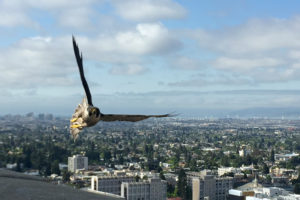
Here at Berkeley it feels a lot like we skipped spring this year entirely, moving quickly from a cold and wet winter to gloriously warm and sunny days. Unlike much of the campus, the Oral History Center doesn’t exactly shut down during the summer, but we do switch gears a bit.
In recent years we’ve come to rely increasingly on the workplace contributions of our amazing student employees. In fact, over the past year, we’ve benefited from the hard work of eighteen Berkeley students. They’ve worked on a variety of projects and tasks, from creating metadata for oral history video now streaming online to drafting tables of contents for our transcripts, plus a whole lot more. With this particular change of seasons, we sadly say goodbye to a number of excellent students — while also congratulating them on graduating! — including Maggie Deng, Cindy Jin, Carla Palassian, and Marisa Uribe.
Summer also typically means travel for those working at the university. Travel, as it turns out, has become a regular feature of life year-round at the Oral History Center in recent years. Our Getty Trust oral history project has had several interviewers traveling to New York and Los Angeles to do their work, the Chicano/a Studies project has sent us to various in the West and Southwest, and our oral history with former California Governor Jerry Brown means regular overnight trips to his ranch outside of Williams, California, for some pretty intense interview sessions. Oral history at Berkeley is no longer just a local or, even regional, affair. We follow our research to where the good, important, and impactful stories are located, no matter what the season.
Thinking about the change of seasons also reminds me of that moving passage from the Book of Ecclesiastes, brought into popular culture in the 1960s by the Byrds in their song “Turn Turn Turn”: “To everything there is a season, and a time to every purpose under heaven.” I think of this now, a day after the passing Herb Sandler, a narrator I worked with very closely over the past three years on his lengthy life history interview, and a broader project that resulted in another 18 interviews. Herb was a giant in whatever work he pursued. He was always deeply involved, passionately motivated, prophet-like in his indignations, compassionate beyond reason, and never ever considered retirement as an option. I join the chorus of those who express sadness at seeing him leave us, and I am grateful to have had the opportunity to work with him to document his life’s work.
Compared to many institutions, the university remains closely tied to the seasons. And while the staff of the Oral History Center doesn’t follow the academic calendar as would an academic department, we are deeply affected by the seasons and by the cycles of life — by the arrival and departure of our student employees, by the beginning of an oral history and by the passing of a respected narrator. As I type this, looking over me from 20 stories up are Carson and Cade, two peregrine falcon chicks whose lives, up until this week, were lived on a precipice of Sather Tower. Now, they are in flight, beginning to explore the world around them.
-Martin Meeker, Charles B. Faulhaber Director, Oral History Center, UC Berkeley
OHC Director’s Column, May 2019
Every April, as the school year is fast coming to a close, the Oral History Center hosts its very own commencement ceremony. For seven years running, we have produced this event to celebrate the oral history class of that year — meaning we thank and honor those people whose interviews were completed in the previous year. The Oral History Class of 2019 numbered some 111 individuals who participated in a number of oral history projects ranging from environmental regulation and wine growing to philanthropy and scientific discovery to opera and an army base.
This very special event gives us an opportunity to reflect on what we do — the meaning of oral history to us, to our narrators, and to the community at large. This year we were thinking about how oral histories “make history” in several ways: The interviews, once recorded and made available to the public, provide the raw material that is then used for the making of historical narratives by historians, journalists, students, you name it; the interviews offer historical narratives and analysis on their own, and thus they are one account of history, maybe the best first draft of history; and, perhaps most importantly, those we interview have already made history by living their lives — by building corporations, participating in social movements, creating works of art, running for political office, serving in the military, mentoring students . . . by making wine! History happens — and has happened — but through the work of the Oral History Center, and the generous and essential contributions of our narrators, history is made.
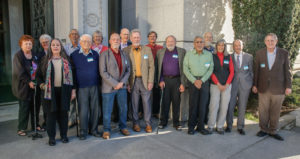
In advance of the event, I asked my colleagues for some examples of moments from their interviews when history was made — when something was told that seemed new to the historical record or in some way demanded a rethinking of it; when a narrator provided an account of a previously unrecognized contribution made — really any example of when history was made.
Amanda Tewes, in her first interview for the center, interviewed Jeanne Rose, who joined us the for event, which was held on this year on Thursday, April 25. Jeanne is a remarkable woman who, in her interview, provided deep insight into something that most people think they know well: the 1960s counterculture. In her telling, we learn of a loose-knit group who were the first 100 to populate the Haight-Ashbury, their deep connections to Big Sur, and how they began to change history with the “Summer of Love” in 1967. We further learn that 60s counterculture didn’t die at the infamous and bloody Altamont concert (which she attended) as the majority of her interview covers the 1970s and beyond when she became an influential herbalist and aromatherapist. With Jeanne Rose, the ideals and the spirit of the 60s live on. Jeanne Rose made history.
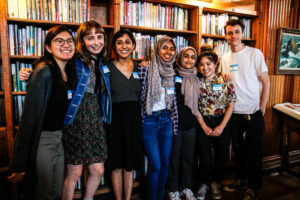
Maggie Deng, Carla Palassian, Gurshaant Bassi, Tasnima Naoshin, Aamna Haq, Laurel Fujii, Ben Satzman. Not pictured: Yarelly Bonilla-Leon, Cindy Jin, KD Mireles, Mason Osberg.(Photo by J.Pierre Carrillo for the UC Berkeley Library)
Todd Holmes, a historian with the Center since 2016, has created a remarkable project documenting the origins of the academic field of Chicano/a Studies, and for this he interviewed Ed Escobar, an Arizona State professor. In his oral history, Escobar tells how he pioneered some of the earliest Latino history courses — out of necessity because there were none. Teaching on the East Coast and then the midwest he learned that the Mexican American experience did not resonate like it did in California. But the Cuban, Puerto Rican, Dominican did. So he put together one of the first Latino history classes on those regions, expanding the definition of Latino and Latino studies in the process. Ed Escobar made history.

We have been fortunate to partner with the East Bay Regional Park District for a few years now and we’ve done a few dozen interviews already — covering many different topics from ranching to public education. Shanna Farrell, who is the project director and lead interviewer, shared with me a moment in her interview with Lawson Sakai. Sakai’s parents were from Japan, so in World War II, his family left the mandated West Coast exclusion area to avoid internment, ultimately settling in Colorado. They returned to California and to farming after the war, but with no money and an unwelcoming attitude of locals, this wasn’t easy. Enter Driscoll Farms, which is a larger grower of fruits today. Immediately after the war, they offered the returning Japanese-Americans a good deal, which included a 50/50 split on profits from the strawberry harvest. According to Sakai, this helped many families back on their feet after the war, allowing them to earn enough money to buy their own farms and thus independence. Shanna said, “I scoured my food history books and didn’t find any information about this. I felt like I had stumbled upon a hidden historical gem.” Lawson Sakai made history.
This past year we renewed our long-running partnership with the Sierra Club to document the organization’s history, and Roger Eardley-Pryor conducted two interviews this year, one with former president Michele Perrault. Roger recalled for me how this interview provides a unique and personal window into the international dimensions of environmentalism. Perrault told stories of traveling to the Soviet Union, China, and India in the early 1990s where she and her colleagues networked with proto-environmental groups, teaching them how to organize and what the key issues were. Their work resulted in, among other things, the creation of some of the first nature preserves in those countries and the establishment of the robust network that is in place today. Michele Perrault made history.
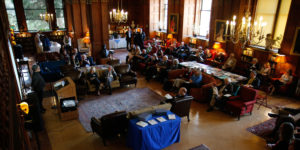
In the coming weeks and months, we will release the oral histories that are not already posted online. This past year we conducted at least 500 hours of new interviews and we are deeply grateful for the support of numerous individuals and institutions for making this work possible. Soon we will begin to post the names of these sponsors on our website so you can thank them too. In the meantime, enjoy the photos and our video from the commencement, highlighting interviews from the Oral History Center Class of 2019.
Our 10-minute video features highlights from the interviews of all of the narrators who were able to attend commencement, plus some bonus interviews. Our remarkable narrators share their insights about nature, science, art, the university, wine making, and more.
Martin Meeker, Charles B. Faulhaber Director, Oral History Center, UC Berkeley
Over the decades, the Oral History Center has conducted more than 4,000 interviews on almost every topic imaginable. As part of UC Berkeley’s commitment to open access, the transcripts are available to researchers and the public at no cost, and almost all of the transcripts are available online. Search our vast collection.
New Project Release: Marion and Herb Sandler Oral History Project
New Project Release: Marion and Herb Sandler Oral History Project
Herb Sandler and Marion Osher Sandler formed one of the most remarkable partnerships in the histories of American business and philanthropy—and, if their friends and associates would have a say in things, in the living memory of marriage writ large. This oral history project documents the lives of Herb and Marion Sandler through their shared pursuits in raising a family, serving as co-CEOs for the savings and loan Golden West Financial, and establishing a remarkably influential philanthropy in the Sandler Foundation. This project consists of eighteen unique oral history interviews, at the center of which is a 24-hour life history interview with Herb Sandler.
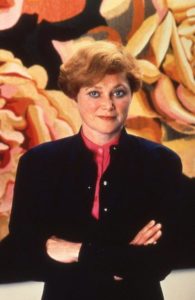
Marion Osher Sandler was born October 17, 1930, in Biddeford, Maine, to Samuel and Leah Osher. She was the youngest of five children; all of her siblings were brothers and all went on to distinguished careers in medicine and business. She attended Wellesley as an undergraduate where she was elected into Phi Beta Kappa. Her first postgraduate job was as an assistant buyer with Bloomingdale’s in Manhattan, but she left in pursuit of more lofty goals. She took a job on Wall Street, in the process becoming only the second woman on Wall Street to hold a non-clerical position. She started with Dominick & Dominick in its executive training program and then moved to Oppenheimer and Company where she worked as a highly respected analyst. While building an impressive career on Wall Street, she earned her MBA at New York University.
Herb Sandler was born on November 16, 1931 in New York City. He was the second of two children and remained very close to his brother, Leonard, throughout his life. He grew up in subsidized housing in Manhattan’s Lower East Side neighborhood of Two Bridges. Both his father and brother were attorneys (and both were judges too), so after graduating from City College, he went for his law degree at Columbia. He practiced law both in private practice and for the Waterfront Commission of New York Harbor where he worked on organized crime cases. While still living with his parents at Knickerbocker Village, he engaged in community development work with the local settlement house network, Two Bridges Neighborhood Council. At Two Bridges he was exposed to the work of Episcopal Bishop Bill Wendt, who inspired his burgeoning commitment to social justice.
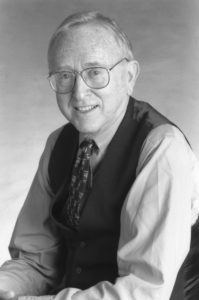
Given their long and successful careers in business, philanthropy, and marriage, Herb and Marion’s story of how they met has taken on somewhat mythic proportions. Many people interviewed for this project tell the story. Even if the facts don’t all align in these stories, one central feature is shared by all: Marion was a force of nature, self-confident, smart, and, in Herb’s words, “sweet, without pretentions.” Herb, however, always thought of himself as unremarkable, just one of the guys. So when he first met Marion, he wasn’t prepared for this special woman to be actually interested in dating him. The courtship happened reasonably quickly despite some personal issues that needed to be addressed (which Herb discusses in his interview) and introducing one another to their respective families (but, as Herb notes, not to seek approval!).
Within a few years of marriage, Marion was bumping up against the glass ceiling on Wall Street, recognizing that she would not be making partner status any time soon. While working as an analyst, however, she learned that great opportunity for profit existed in the savings and loan sector, which was filled with bloat and inefficiency as well as lack of financial sophistication and incompetence among the executives. They decided to find an investment opportunity in California and, with the help of Marion’s brothers (especially Barney Osher), purchased a tiny two-branch thrift in Oakland, California: Golden West Savings and Loan.
Golden West—which later operated under the retail brand of World Savings—grew by leaps and bounds, in part through acquisition of many regional thrifts and in part through astute research leading to organic expansion into new geographic areas. The remarkable history of Golden West is revealed in great detail in many of the interviews in this project, but most particularly in the interviews with Herb Sandler, Steve Daetz, Russ Kettell, and Mike Roster, all of whom worked at the institution. The savings and loan was marked by key attributes during the forty-three years in which it was run by the Sandlers. Perhaps most important among these is the fact that over that period of time the company was profitable all but two years. This is even more remarkable when considering just how volatile banking was in that era, for there were liquidity crises, deregulation schemes, skyrocketing interest rates, financial recessions, housing recessions, and the savings and loan crisis of the 1980s, in which the entire sector was nearly obliterated through risky or foolish decisions made by Congress, regulators, and managements. Through all of this, however, Golden West delivered consistent returns to their investors. Indeed, the average annual growth in earnings per share over 40 years was 19 percent, a figure that made Golden West second only to Warren Buffett’s Berkshire Hathaway, and the second best record in American corporate history.
Golden West is also remembered for making loans to communities that had been subject to racially and economically restrictive redlining practices. Thus, the Sandlers played a role in opening up the dream of home ownership to more Americans. In the offices too, Herb and Marion made a point of opening positions to women, such as branch manager and loan officer, previously held only by men. And, by the mid-1990s, Golden West began appointing more women and people of color to its board of directors, which already was presided over by Marion Sandler, one of the longest-serving female CEOs of a major company in American history. The Sandlers sold Golden West to Wachovia in 2006. The interviews tell the story of the sale, but at least one major reason for the decision was the fact that the Sandlers were spending a greater percentage of their time in philanthropic work.
One of the first real forays by the Sandlers into philanthropic work came in the wake of the passing of Herb’s brother Leonard in 1988. Herb recalls his brother with great respect and fondness and the historical record shows him to be a just and principled attorney and jurist. Leonard was dedicated to human rights, so after his passing, the Sandlers created a fellowship in his honor at Human Rights Watch. After this, the Sandlers giving grew rapidly in their areas of greatest interest: human rights, civil rights, and medical research. They stepped up to become major donors to Human Rights Watch and, after the arrival of Anthony Romero in 2001, to the American Civil Liberties Union.
The Sandlers’ sponsorship of medical research demonstrates their unique, creative, entrepreneurial, and sometimes controversial approach to philanthropic work. With the American Asthma Foundation, which they founded, the goal was to disrupt existing research patterns and to interest scientists beyond the narrow confines of pulmonology to investigate the disease and to produce new basic research about it. Check out the interview with Bill Seaman for more on this initiative. The Program for Breakthrough Biomedical Research at the University of California, San Francisco likewise seeks out highly-qualified researchers who are willing to engage in high-risk research projects. The interview with program director Keith Yamamoto highlights the impacts and the future promise of the research supported by the Sandlers. The Sandler Fellows program at UCSF selects recent graduate school graduates of unusual promise and provides them with a great deal of independence to pursue their own research agenda, rather than serve as assistants in established labs. Joe DeRisi was one of the first Sandler Fellows and, in his interview, he describes the remarkable work he has accomplished while at UCSF as a fellow and, now, as faculty member who heads his own esteemed lab.
The list of projects, programs, and agencies either supported or started by the Sandlers runs too long to list here, but at least two are worth mentioning for these endeavors have produced impacts wide and far: the Center for American Progress and ProPublica. The Center for American Progress had its origins in Herb Sandler’s recognition that there was a need for a liberal policy think tank that could compete in the marketplace of ideas with groups such as the conservative Heritage Foundation and the American Enterprise Institute. The Sandlers researched existing groups and met with many well-connected and highly capable individuals until they forged a partnership with John Podesta, who had served as chief of staff under President Bill Clinton. The Center for American Progress has since grown by leaps and bounds and is now recognized for being just what it set out to be.
The same is also true with ProPublica. The Sandlers had noticed the decline of traditional print journalism in the wake of the internet and lamented what this meant for the state of investigative journalism, which typically requires a meaningful investment of time and money. After spending much time doing due diligence—another Sandler hallmark—and meeting with key players, including Paul Steiger of the Wall Street Journal, they took the leap and established a not-for-profit investigative journalism outfit, which they named ProPublica. ProPublica not only has won several Pulitzer Prizes, it has played a critical role in supporting our democratic institutions by holding leaders accountable to the public. Moreover, the Sandler Foundation is now a minority sponsor of the work of ProPublica, meaning that others have recognized the value of this organization and stepped forward to ensure its continued success. Herb Sandler’s interview as well as several other interviews describe many of the other initiatives created and/or supported by the foundation, including: the Center for Responsible Lending, Oceana, Center on Budget and Policy Priorities, Learning Policy Institute, and more.
Herb and Marion Sandler also played key roles in the formation and funding of two important research centers here on the UC Berkeley campus which have a global reach: the Berkeley Center for Equitable Growth (CEG) and the Human Rights Center. The CEG is directed by economist Emmanual Saez and has supported the influential work of Thomas Piketty which looks at methods for reducing wealth and income disparities around the globe. The Human Rights Center has for the past 25 years investigated and shed light upon human rights abuses around the globe.
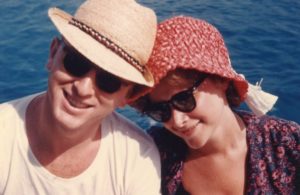
A few interviewees shared the idea that when it comes to Herb and Marion Sandler there are actually three people involved: Marion Sandler, Herb Sandler, and “Herb and Marion.” The later creation is a kind of mind-meld between the two which was capable of expressing opinions, making decisions, and forging a united front in the ambitious projects that they accomplished. I think this makes great sense because I find it difficult to fathom that two individuals alone could do what they did. Because Marion Sandler passed away in 2012, I was not able to interview her, but I am confident in my belief that a very large part of her survives in Herb’s love of “Herb and Marion,” which he summons when it is time to make important decisions. And let us not forget that in the midst of all of this work they raised two accomplished children, each of whom make important contributions to the foundation and beyond. Moreover, the Sandlers have developed many meaningful friendships (see the interviews with Tom Laqueur and Ronnie Caplane), some of which have spanned the decades.
The eighteen interviews of the Herb and Marion Sandler oral history project, then, are several projects in one. It is a personal, life history of a remarkable woman and her mate and life partner; it is a substantive history of banking and of the fate of the savings and loan institution in the United States; and it is an examination of the current world of high-stakes philanthropy in our country at a time when the desire to do good has never been more needed and the importance of doing that job skillfully never more necessary.
Martin Meeker, Charles B. Faulhaber Director, Oral History Center, UC Berkeley
List of Interviews of the Marion and Herbert Sandler Oral History Project
Ronnie Caplane, “Ronnie Caplane: On Friendship with Marion and Herb.”
Joseph DeRisi, “Joe DeRisi: From Sandler Fellow to UCSF Professor of Biochemistry.”
Stephen Hauser, “Stephen Hauser: Establishing the Sandler Neurosciences Center at UCSF.”
Russell Kettell, “Russ Kettell: A Career with Golden West Financial.”
Thomas Laqueur, “Tom Laqueur: On the Meaning of Friendship.”
Bernard Osher, “Barney Osher: On Marion Osher Sandler.”
Michael Roster, “Michael Roster: Attorney and Golden West Financial General Counsel.”
Kenneth Roth, “Kenneth Roth: Human Rights Watch and Achieving Global Impact.”
Herbert Sandler, “Herbert Sandler: A Life with Marion Osher Sandler in Business and Philanthropy.”
James Sandler, “Jim Sandler: Commitment to the Environment in the Sandler Foundation.”
Susan Sandler, “Susan Sandler: The Sandler Family and Philanthropy.”
William Seaman, “Bill Seaman: The American Asthma Foundation.”
Paul Steiger, “Paul Steiger: Business Reporting and the Creation of ProPublica.”
Richard Tofel, “Richard Tofel: The Creation and Expansion of ProPublica.”
Coastal Tales: The Long Struggle to Preserve California’s Coast – New Podcast Just Launched!
by Todd Holmes
“The true history of the Coastal Commission is what you don’t see, namely the developments along the coast the agency either denied or significantly scaled back.”
In 1972, the citizens of California voted overwhelmingly to create a new agency charged with regulating all development along the state’s coastline, an agency that became known as the California Coastal Commission. For nearly 50 years, the Commission has worked with coastal communities to shape development along California’s shore, efforts guided by the dual aims of environmental protection and public access. It is often said that the true history of the Coastal Commission is what you don’t see, namely the developments along the coast the agency either denied or significantly scaled back. This “unseen” history stands at the heart of the 15-episode podcast, Coastal Tales: The Long Struggle to Preserve California’s Coast, a production of the Oral History Center at UC Berkeley in partnership with the Bill Lane Center for the American West at Stanford University. We’ve just launched the pilot episode about saving Lighthouse Point in Santa Cruz, and the rest of the podcast is slated to be released in the fall of 2020.
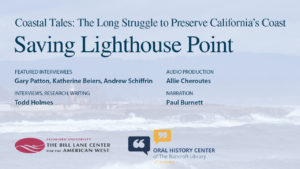
The pilot episode, “Saving Lighthouse Point,” tells the story of the fight in Santa Cruz during the early 1970s against massive development that sought to turn one of the city’s last open parcels of coastal land into a bustling tourist and business hub. Bolstered by the creation of the Coastal Commission, the citizens of Santa Cruz organized and challenged the city council’s support of the project, ultimately saving Lighthouse Point. The successful campaign not only came to stand as a testament to the Coastal Commission and its influence in many coastal communities, but also would prove a watershed moment in the history of Santa Cruz.
Each episode of the podcast will feature a specific site on the state’s coastline and detail the story of a proposed development that, if not for the Coastal Commission, would have significantly altered those sites and communities forever. Led by Todd Holmes, a historian at the Oral History Center and affiliated scholar with Stanford’s Bill Lane Center, the podcast draws on oral history interviews currently underway with former staff and commissioners of the agency, as well as community activists closely involved with the Commission over the decades. The project also draws on Holmes’ research conducted with the California Coastal Commission Project, which the Bill Lane Center initiated in 2014. When complete, the 15 episodes of Coastal Tales will be housed on a dedicated website that will feature the full transcripts of the interviews along with additional information and resources on the history of the Commission. The public will also eventually be able to access the episodes at the sites themselves with the scan of a QR code.
If you’d like to learn more about this project, please contact Todd Holmes at todd.holmes@berkeley.edu or 510-666-3687. You can also support our future episodes by writing California Coastal Commission in the special instructions section of the donation form.
Listen to the pilot episode, read the oral histories, and and be sure to stay tuned for more information!
The Oral History Center is pleased to announce our inaugural UC Graduate Student of Color Fellow, Rudy Mondragón, for Summer 2019!

Mondragón is a doctoral candidate at the University of California, Los Angeles working on a project that looks at the sport of boxing and the ways in which black and brown boxers politically and culturally express themselves via the famous ring entrance. Academically, Mondragón has written reviews of the boxing documentary “Champs” for the Journal of Sports History and Louis Moore’s I Fight for a Living: Boxing and the Battle for Black Manhood, 1880-1915, for the International Review for the Sociology of Sport. He has also written on boxing for Remezcla, We Are Mitú, and L.A. Taco and has been quoted in CNN and Bleacher Report articles and interviewed by ESPN Deportes-Seattle. More recently, he contributed an article and photographs of professional boxers José Carlos Ramírez and Carlos “The Solution” Morales for The Streets Magazine. Mondragón is the recipient of the prestigious University of California Cota Robles Fellowship, NCAA Ethnic Minority Enhancement Postgraduate Award, and Arthur Ashe Jr. Sports-Scholar Award. In the summer of 2017, Mondragón was a Fellow of the Smithsonian Latino Museum Studies Program in Washington DC where he conducted interviews for the Latinos and Baseball Project.
A Word from Mondragón on His Project:
My research advances conversations in the fields of critical sports studies, Chicana/o/x studies, cultural studies, and American studies. I explore the sport of boxing and the ways in which professional fighters deploy expressive culture (music, style, fashion, and entourages) in their ring entrances. I conceptualize the ring entrance as a political site of struggle where boxers communicate new forms of subjectivities and identities, and at times, both overtly and covertly perform dissent and resistance to dominant ideologies and structures of power. Given that boxers navigate a hyper-capitalist and neoliberal sporting industry that is unregulated, I argue that boxers are vulnerable pawns that navigate a shifting sports market as well as the effects of dominant ideologies of race, gender, sexuality, and poverty. For me, the ring entrance has spatial dimensions of infinite possibilities that allows fighters to subtly and creatively reimagine an alternative world and liberation.
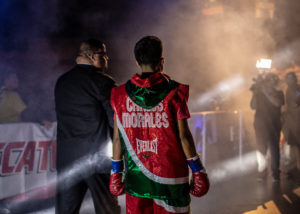
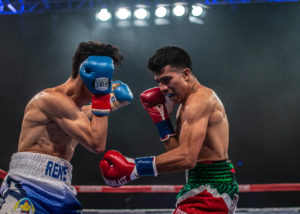
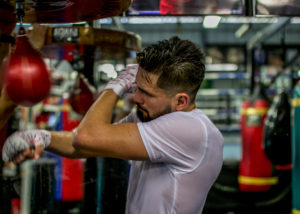
All photos by Rudy Mondragón
We recently caught up with Mondragón to ask him about his background, how he became interested in boxing, and who he plans to interview this summer.
Q: Tell us a little bit about yourself. Where do you go to school and what are you studying?
I am in the fifth year of my doctoral studies at the University of California, Los Angeles. I am working on my PhD in Chicana and Chicano Studies. When I first started my studies, I was planning on conducting a 16th century cultural history on indigenous communities in Central Mexico to interrogate race and religious hegemony. That didn’t really work out [chuckle]. I have always been passionate about boxing. A couple of weeks into my first quarter of graduate school, I realized that I had not watched a single boxing match in over a month. Something clicked in my mind and heart. I mentally checked out of the seminar and started writing down my ideas about how boxing could be an area of study that would allow me to interrogate race, history, stories, culture, and athletic-activism. I was excited but also worried that my ideas would not be accepted. That’s when I decided to talk with Dr. Gaye Theresa Johnson. I trust her greatly, so we scheduled a Skype meeting, so I could share my new research vision. I’ll never forget what happened during our talk. As I shared my ideas, Dr. Johnson reached over the table and grabbed a book. She put the book in front of her laptop camera, so I could see the cover. The book was about women and boxing! It was the sign I needed to pursue this area of study. Dr. Johnson is now the chair of my committee.
Q: How did you become interested in researching professional boxing?
My parents got me into watching professional boxing. I was 7 years old in the summer of 1992. This was the year that the Fight of the Century was to take place between Julio Cesar Chavez and Hector “Macho” Camacho. The fight was being advertised everywhere. My mother would always have a Spanish print of the local television listings. I remember the September issue of that print featured both boxers on the front cover. It was my mom who indirectly put me on to boxing. On the night of September 12, 1992, my father took me to my uncle Felipe’s house for the big fight. As a working-class family, the reason we went to his house for the fight was because he had a black box, which was a device designed to gain illegal access to all cable television channels. This meant that pay-per-view events, like this fight in particular, would not cost my uncle a single dime. I remember rooting for Chavez because his Mexican nationality was similar to my father’s. I wanted Chavez to win, but as I watched some of the behind the scenes footage from Camacho’s dressing room, I began to gravitate towards the Puerto Rican fighter. He was flamboyant, flashy, loud, and full of energy. He had a boxing outfit that resembled a Captain America suit. The only difference was that on the back of the red, white, and blue outfit was a huge “M” for Macho. His suit was representative of Captain Puerto Rico or Captain Macho. It was really awesome because it was a proud statement about who he was. As Camacho made his way out his dressing room and towards the tunnel to start his ring walk, the sounds of McFadden and Whitehead’s “Ain’t No Stopping Us Now” blasted inside the Thomas and Mack Center in Las Vegas. I remember seeing Puerto Rican flags in the stands, fans were dancing, and Camacho’s mom had her hands raised in the air as her son danced his way to the ring. I didn’t know it at the time, but that was the moment where my research on professional boxing got started. Since then, I’ve never stopped watching, studying, discussing, and now, writing about and photographing the world of boxing.
Q: You’re planning to interview Fernando “El Feroz” Vargas, a two-time light middleweight world champion who boxed from 1997 – 2007. How did you choose him and what topics and themes are you hoping to explore with him in your interview?
I was 17 years old when I first watched Fernando Vargas (AKA El Feroz and The Aztec Warrior). This was in 2002, a year after the September 11 attacks in New York. This match was one of Fernando’s biggest career fights. He was going up against Oscar De La Hoya, a fighter that I was a huge fan of. Seventeen-year-old me was thrilled to watch De La Hoya fight against Vargas. Part of my fandom for De La Hoya was due to my alignment with De La Hoya’s identity performance. Oscar was the definition of the American Dream for some Mexican Americans. He is what the boxing world considers a corporate fighter, which in his case, meant he cultivated his career as a clean-cut corporate friendly fighter who performed a respectability that made him consumable by Mexican American middle-class and usable by corporate brands. It wasn’t until I got older and began to take Chicana and Chicano Studies courses that I realized why Fernando Vargas’s performance of identities was so important. Vargas’s fight with De La Hoya took place in the post-9/11 moment. This was a moment in which Michael Silk describes as a time in history where “dissent was silenced, a time in which it was not possible to fully articulate a sense of being American outside that which was normalized.” It was also a time when US Immigration and Customs Enforcement (ICE) agency was formed and the number of noncitizens detained in detention centers skyrocketed. Rather than assimilate to the political moment, Vargas entered the ring for his fight against De La Hoya in an unapologetic, courageous, and creative manner. He walked to the ring to live Mexican ranchero music, wore the colors of the Mexican flag, and was sponsored by DADA, a brand that was popular among hip hop communities. The media and fans often described him as a thug because of the way he dressed, his bald head, and his masculine bravado. This unapologetic performance in the post-9/11 moment is why Vargas matters as he can teach us a great deal about the ways in which subtle resistance can be performed within a sports and political context through the deployment of expressive culture. In his case, music and fashion.
As such, some of the themes I hope to explore are Fernando’s autobiography, particularly his childhood when he lived in the agricultural city of Oxnard, California and how he found the sport of boxing. Often, boxing is a sport that recruits people from low-income and poverty. For a select few, boxing serves as a vehicle out of poverty. I also want to explore his relationship with his former trainer, The Big G, who has had a huge impact on Fernando’s life both in and out of the ring. Fernando was also known for his ring entrances that featured the song “No Me Se Rajar” (I do not quit), Aztec pyramid stones that he would punch through to get to the boxing ring, and the use of Mexican and Aztec symbols for his ring attire. By exploring Fernando’s ring entrances, I will be able to explore Fernando’s multiple identities and how those informed the curation of his ring entrances. And finally, I want to center his experience as a boxer who fought in the pre-and post-9/11 moment. In particular, I want to learn more about his claims to dignity and cultural pride during this historical period.
Q: What are you most excited to get out of your fellowship with the OHC?
The timing of being awarded this fellowship was terrific. I just defended my dissertation proposal, making me a doctoral candidate. As I am on the eve of conducting interviews with professional boxers for my dissertation project, this fellowship will allow me to gain necessary guidance from Shanna Farrell. It will also give me a hands-on experience in conducting the longest oral history to date in my career. I am excited about this because I will have experts from the Oral History Center providing me with direction, feedback, and critique that will help refine my current skill set and strengths when it comes to conducting interviews and oral histories. I’m also excited to contribute the first oral history with a professional fighter to be archived at a prestigious research library.
OHC Director’s Column, March 2019
by Martin Meeker; @MartinDMeeker
How do thoughtful, articulate, quiet people who have something to say get heard? In this day and age in which the loudest voices, the most outlandish ideas, and the most shocking stories get the greatest attention, is there even room for the longform, deep-dive oral histories that the Oral History Center produces? We certainly think that there is — actually, we’re pretty sure that not only is there a place for these interviews, but there is a real need for them. This leaves us with the question: how do we spread word of the remarkable interviews that we conduct? What’s the best way for people who could benefit from our work to learn about it and thus use it?
Since you’re reading this newsletter, you’re already in the loop and engaged with what we do (and we thank you for paying attention!). But we are also constantly examining the ways in which we attempt to connect and considering potential new avenues for outreach. Like most every organization today, we have a pretty robust social media presence. We use our feeds (twitter, facebook, instagram, youtube, and soundcloud) to announce the completion of new oral histories, to pay tribute to narrators who’ve achieved something or sadly passed away, or just to share things reasonably related to oral history which might interest our community. Have you engaged with us on social media? Are you interested in what we have to say? Do you think we might use it better? We want to know.
We try to extend our reach by hosting educational seminars and institutes, by speaking to classes and community groups, and by simply answering our emails (but we get a lot, so apologies in advance if I take a few days to get back to you!). We recognize that a 300-page oral history transcript is sometimes a difficult nut to crack, so we produce brief clips introducing folks to some main themes or interesting moments drawn from the interviews, and share these as widely as possible. We have begun producing podcasts and, soon, longer format videos to show ways in which the original recordings of our interviews can be used to create engaging and informative analytic pieces — and thus encouraging others to use our oral histories in similar ways. And, of course our transcripts continue to provide extraordinarily valuable, irreplaceable evidentiary bases to mountains of books, articles, and theses. What are other options that we might use to spread word of the remarkable interviews? How might the transcripts and recordings be used in novel and enlightening ways?
The big questions posed above are now being addressed head-on by our newly refurbished and expanded production/operations/communications team at the Oral History Center. As a result of a recent search to fulfill our “Communications Specialist III” vacancy, we hired two immensely qualified individuals. David Dunham, who has been on our staff for many years in other capacities, has assumed the new role of Operations Manager; Jill Schlessinger, who came to us from UCB Student Affairs, has joined us as Communications Manager. In addition to working as a team to make sure we continue our successful production of dozens of oral histories every year, Jill and David are tackling these very thorny questions focused on how to raise our collective voice so that the voices of narrators are heard and the content of their oral histories is widely known. Expect to hear more from us in the coming months as all of this comes to fruition. As always, we welcome your input and we’re happy to listen — you might say that’s something we do rather well!
Martin Meeker
Charles B. Faulhaber Director
Meet Jill Schlessinger, the Oral History Center’s New Communications Manager
The Oral History Center is pleased to announce our newest staff member, Jill Schlessigner. She joins our team as Communications Manager. We caught up with her recently to chat about her background in history, interest in oral history, and the projects that she’s most excited to embark on with the OHC.
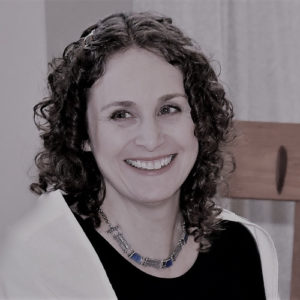
Q: When did you first encounter oral history?
Schlessinger: As an undergraduate at UC Berkeley, I chose a senior thesis research course that was about oral history. I studied the field of oral history interviewing and research methodology and wrote an oral history thesis. I studied female college students’ attitudes towards abortion from the 1950s to 1980s. Interviewing people from different backgrounds and perspectives taught me a lot about the importance of solid preparation, not making assumptions, and keeping an open mind.
Q: You recently joined our team as a Communications Manager. What were you doing before the OHC?
Schlessinger: Before joining the Oral History Center, I was a content strategist in Student Affairs Communications at UC Berkeley. I’ve had the opportunity to work in a number of fields in my career — higher education, health care, human resources, technology — and I find working in education to be especially fulfilling.
Q: You have a PhD from UCB in History. What did you study?
Schlessinger: I studied US History at the turn of the century, with a focus on social history and women’s history. My dissertation, “Such Inhuman Treatment”: Family Violence in the Chicago Middle Class, 1871–1920, was an analysis of changing power dynamics and community intervention in middle-class families. Something interesting I learned was that many Chicago residents, without anywhere else to turn, pressured the local Society for the Prevention of Cruelty to Animals to address cases of child cruelty, and the Society ultimately changed its mission and name. The Illinois Humane Society became a pioneering child-saving organization. This is something that happened in cities across the country, and numerous animal protection agencies also expanded to protect children and other vulnerable people from physical cruelty.
Q: Which of the OHC interviews do you feel the most connection to, either because of your PhD or current interests?
Schlessinger: It’s challenging to choose just one project because the Oral History Center’s interviews touch on so many of our society’s most pressing issues. However, I would say I feel a connection to the interviews from the Rosie the Riveter World War II American Home Front collection. The Rosies are an important part of women’s history, the history of World War II, and our local history here in the East Bay, and I’ve always found their stories inspiring. On a fun note, I helped break the Guinness world record for the most people dressed as Rosie the Riveter in one place! It’s wonderful that the Oral History Center is instrumental in preserving these voices.
Q: What projects are most excited to be working on?
Schlessinger: The team at the Oral History Center produces an enormous amount of important work. There are the oral history interviews, of course, which delve into the thinking of some of California’s — and the world’s — greatest pioneers and influencers. And the podcasts based on these interviews bring to life the experiences of our narrators and the causes they championed. The Center also conducts a number of educational programs, which reach beyond academics to support journalists, public historians, independent scholars, and others to deepen their interviewing and research skills. We also employ a small army of students who help us with video and transcript production, research, communications, and more. Without them, our historians wouldn’t be able to conduct so many interviews, and it’s wonderful that in turn we are also able to give our students meaningful research and work opportunities. I’m excited to develop a communications plan that helps the Oral History Center share all of this marvelous work, so that people are able to take advantage of everything we have to offer.
Q: How do we get in touch with you?
Schlessinger: You can reach me at jill.schlessinger@berkeley.edu. I’d love to hear from anyone who is interested in helping us share the stories of our narrators and the Center.
Oral History Center Leads Introductory Workshop
by Shanna Farrell; @shanna_farrell
When Spring rains shower the Bay Area, saturating the ground and greying the skies, we know it’s time for our annual Introductory Oral History Workshop. On Saturday, March 2nd, as raindrops beat against our stained-glass windows, we welcomed a group of forty to campus, where they they learned the nuts and bolts of doing oral history . They braved the wet weather to join us from all over Northern California , and even as far as North Carolina.
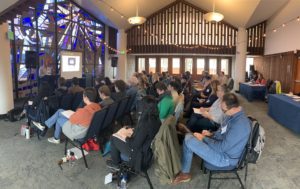
The oral history project topics of attendees varied from burlesque to the Third World Liberation Front, and from the mining industry to environmental conservation. However, we design our introductory seminars to be applicable for everyone. OHC Director Martin Meeker gave an overview of what makes oral history oral history. Paul Burnett and Roger Eardley-Pryor discussed the intricacies of project planning. Amanda Tewes and Shanna Farrell led a discussion on interviewing techniques. Burnett and Meeker shared recording tips and tricks, and Tewes and Todd Holmes shared potential uses of oral history drawing from a cadre of past projects.
The workshop also featured a live interview exercise led by Farrell. One of the workshop participants, Trisha Pritikin, volunteered to be interviewed by Farrell so other attendees could see an oral history unfold in real time. Eardley-Pryor then engaged Farrell, Pritikin, and workshop participants in a group discussion. Attendees shared their observations, asked Farrell about certain lines of questioning , and inquired how Pritikin felt sitting in the “hotseat.”
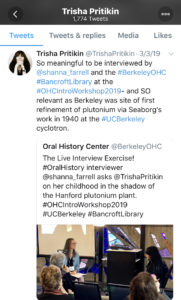
These workshops always prove inspiring for OHC interviewers, staff, and student supporters because we interact with attendees who share our passion for oral history.
Thanks to all of you who made the workshop so great! And if you missed it this year, we’ll see you next Spring in 2020!
Want more oral history training? Check out our Advanced Oral History Summer Institute. Email Shanna Farrell (sfarrell@library.berkeley.edu) with questions.